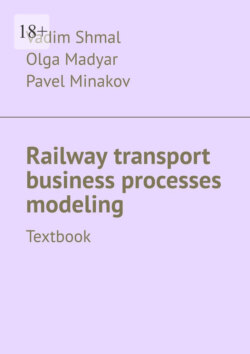Читать книгу Railway transport business processes modeling. Textbook - Vadim Shmal - Страница 4
1 BUSINESS MODELS, THEIR DEVELOPMENT HISTORY AND CLASSIFICATION
1.3 The main stages of building a enterprise business model
ОглавлениеBusiness modeling is an ambiguous process and it is never possible to accurately predict the demand for a company’s activities. It is possible to formulate an abstract business model of an enterprise by creating its template – a general scheme consisting of 9 blocks (Figure 1.5) reflecting the logic of the work of any company (Figure 1.6).
1 Block – Consumer segment (customers).
This block determines the consumer base of the company, because the client is the heart of the business model, from which the main blocks will be based. Consumer segments are divided into 6 categories, the difference of which is due to differences in offers, requests and sales channels (Figure 1.7).
2 Block – Offer (provided value).
The offer block reflects a certain value for the segment of consumers, which can be both quantitative and qualitative. The value of the offer can be formed by the elements presented in Figure 1.8.
3 Block – Distribution channels (distribution channels)
Distribution channels have several phases and can be divided into direct, indirect, as well as own and partner. The stages of product promotion to the consumer are shown in Figure 1.9. Product promotion channels may include all or some stages.
Block 4 – Customer Relations
Customer relationships are divided into several types, for a certain segment of consumers, these relationships can be implemented in parallel. The customer relations block helps to answer frequently arising questions of cost, implementation in practice, segmentation of consumers for a certain type of relationship, etc. The types of customer relationships are shown in Figure 1.10.
5 Block – Income flows (revenues)
Revenue flows exist for each consumer segment. They can be single for each segment, and several flows can be intended for one consumer segment. Revenue channels may have an individual pricing mechanism. Ways to create revenue streams are shown in Figure 1.11.
Block 6 – Core resources (key resources)
Key resources primarily allow you to make a profit, as well as provide an opportunity to inform customers about your offers and ensure relationships with your target audience. The type of use of key resources also depends on the classification of the business model (Figure 1.12).
Block 7 – Main activity (key activities)
The main activity of the company is divided into 3 categories (Figure 1.13). The activity block helps to determine the appropriate distribution channels, the main actions necessary for the implementation of a product or service, as well as answer questions about further customer relations and determine the method of revenue flow.
Block 8 – Key Partners
During the work of the company, relationships with partners are built. There are three main motives for creating partnerships: optimization and economies of scale, reduction of risks and uncertainty, acquisition of certain resources and activities. Key partners can be divided into 4 classification groups (Figure 1.14). Partnership is necessary to support the company, its functioning through the attracted infrastructure, optimization, production savings, as well as in the framework of logistics (supplies) and joint activities.
9 Block – Expenses structure
Any business model should be based on minimizing expanses. In this block, it is possible to determine what expenses the company will have for the functioning of its business model. There are two broad classes of expenses structure: the focus on expenses and the focus on value, where most business models lie between these classes. The former always strive to ensure minimized expenses for providing their value, and the latter to ensure the quality of their products. Expenses, in turn, can also be divided into groups (Figure 1.15).
